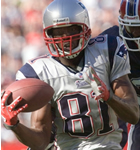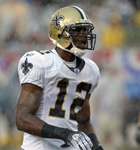Target Practice
9/27/07
 The “Gut Feeling” is often synonymous with a sense
of desperation resulting from a lack of preparation. The Gut Check
is a huge proponent of studying the numbers, but there’s
a point where one can place too much emphasis on the wrong information.
This can result in the undervaluing or overlooking a player’s
potential. Therefore, The Weekly Gut Check is devoted to examining
the frame of reference behind certain number-driven guidelines
that fantasy football owners use to make decisions.
The “Gut Feeling” is often synonymous with a sense
of desperation resulting from a lack of preparation. The Gut Check
is a huge proponent of studying the numbers, but there’s
a point where one can place too much emphasis on the wrong information.
This can result in the undervaluing or overlooking a player’s
potential. Therefore, The Weekly Gut Check is devoted to examining
the frame of reference behind certain number-driven guidelines
that fantasy football owners use to make decisions.
Although The Weekly Gut Check doesn’t claim to be psychic,
he does believe that he can dispel certain numbers biases and
help you make the best choices for your team. We’ll keep
a running tally of The Weekly Gut Check’s insights. This
way you can gauge his views as something to seriously consider,
or at least seriously consider running the opposite way as fast
as you can!
With three games in the books, let’s take some early target
practice and analyze the conversion rates of wide receivers and
tight ends. Hopefully the numbers will reveal who is likely to maintain
their production, whose early start is more likely a fluke, and
which receivers are worth adding to your roster if they are sitting
on your waiver wire.
The table below is a list of the top 40 fantasy receivers according
to the FFToday Default scoring system. I have added a conversion
percentage (receptions divided by targets) and sorted the results
by this calculation. The number to the left of the player is that
player’s actually ranking by total fantasy points scored
after three games.
If you haven’t noticed, Randy Moss has truly returned as
the best fantasy receiver in football. He’s converting a
whopping 88% of his targets and predictably leads the league in
touchdowns. As for the Raiders telling the league Moss lost a
step, the Patriots deep threat is averaging over 18 yards per
catch. Last I checked, only guys with speed consistently average
over 14 yards per reception. This information is all obvious,
but what isn’t as obvious is what you should learn about
reading and listening to analysts with a critical eye—including
yours truly.
 If
you listened to many of the preseason media pundits, including
former players who recently left the NFL, who said Moss lost a
step then you likely crossed the best fantasy receiver off your
draft board at the spot you should have enthusiastically picked
him. I understand that no one was sure the Patriots were sandbagging
about Moss’ injury and lack of practice time. I also get
that Moss’ past few years have been a disappointment. Since
these two reasons why Moss wouldn’t be back to his old self
have been rejected faster than Jenni Carlson attempting to crash
a Gundy family reunion, let’s establish why Moss may have
tricked these “experts” into thinking he lost a step. If
you listened to many of the preseason media pundits, including
former players who recently left the NFL, who said Moss lost a
step then you likely crossed the best fantasy receiver off your
draft board at the spot you should have enthusiastically picked
him. I understand that no one was sure the Patriots were sandbagging
about Moss’ injury and lack of practice time. I also get
that Moss’ past few years have been a disappointment. Since
these two reasons why Moss wouldn’t be back to his old self
have been rejected faster than Jenni Carlson attempting to crash
a Gundy family reunion, let’s establish why Moss may have
tricked these “experts” into thinking he lost a step.
The most obvious reason is Moss’ tendency to run some uninspired
routes when he’s not the intended target or the game is
way out of reach. This has long been a valid criticism of Moss’
game, but this is about laziness rather than lost speed. But this
laziness has become a long-held media perception of the receiver.
They listen to past interviews and watch a half dozen plays during
several games where he’s loafing and they harp on the “I
play when I want to play,” statement.
As a result they judge Moss’ as a player who lacks the
desire to be the best. They don’t say Moss is soft, but
they come very close when they prejudge him as a prima donna who
doesn’t give his full effort or cares about the team. If
you recall, Randy Moss played hurt in several games for the past
two years. Like many New England Patriots, Moss didn’t talk
much about his injuries and didn’t make excuses although
it was clear from the game film that the former Raider seemed
a bit off his game when one watched his body language after taking
a hit.
Mike MacGregor told me last year that he thought Moss was at
the end of his dominance because of his recent injuries. At least
this viewpoint was based on something tangible and not an unfair
media-held perception of a player that teammates always disputed.
Did you ever hear a player say Moss was a team cancer? Last I
checked, player after player said Moss was a leader in the locker
room and worked hard. I know Moss has done some boneheaded things
and this has made him an easy target for media types who are heavy
on television hoopla, but light on substance.
Unfortunately it’s just these types of talking heads who
fuel inaccurate perceptions of a player. Take Joe Buck, a second-generation
announcer who thinks football should be as clean as June Cleaver,
(although football’s history of trash-talking and behavior—especially
in the 50s—has long been as rough and ready as Joan Jett)
rails Randy Moss for his mock mooning of the Green Bay fans. Mind
you, this is something the fans actually do to the opposing team
as a Lambeau tradition. If anything Moss’ response was clever,
but Buck painted him as classless.
But I’m not trying to argue that Moss is suddenly saintly
because he’s producing. He’s obviously done bone-headed
deeds while in the NFL. The point is all the negatives about Moss’s
behavior negatively influences others views of him. Sometimes
media analysts act like a bunch of gossiping churchgoers at a
Sunday picnic.
What all these people overlooked, which some of the more astute
former NFL players—especially quarterbacks—pointed
out game after game with the Raiders, was the fact Moss’
quarterbacks did not release the ball with enough anticipation.
Aaron Brooks and Kerry Collins held onto the ball too long. The
deep passing game isn’t just about receivers getting separation.
It’s just as important that the quarterback throws a timely
and accurate pass. It’s common sense; if Moss has separation
30 yards down the field and the farthest his QB can toss a pass
is 50 yards in the air that means the ball has to leave the QB’s
hand with enough time to get to Moss in those last 20 yards. Either
the pass has to be thrown with amazing velocity at the last-second,
which is not likely, or the QB has to release the ball with enough
time to arc a long ball into the arms of his pass-catcher.
Aaron Brooks was known as a quarterback who did not make good
decisions. He did not consistently recognize the open man early
enough in the route progression and this meant he either had to
improvise or throw a ball into tight coverage. Kerry Collins held
onto the ball too long. When he would release the football, it
was often so late in the route progression that Moss would have
to slow down and allow the defensive backs in coverage to reach
him as the ball was getting to him. As you can see this isn’t
about foot speed as much as it is about the speed of the quarterbacks
recognizing Moss was open.
A great example of a quarterback who recognizes an opening and
shows excellent anticipation is Marc Bulger. He’s having
an off year, but generally his timing is half the reason why Bruce
and Holt have remained a devastating receiving corps. You can
also attribute this to Mike Martz if you see how well John Kitna
throws the deep ball. It’s also the difference between Kurt
Warner and Matt Leinart last week—one understands timing
better than the other. Just look at the top fantasy producers
at this position thus far and you’ll mostly see deep threats
with quarterbacks who show excellent anticipation: Moss (Brady),
Chad Johnson and T.J. Houshmandzadeh (Palmer), Roy Wiliams (Kitna),
and Anquan Boldin (Warner in last week’s game where Boldin
got his).
But the best converters of targets arenít usually the deep
threats. Wes Welker, Mike Furrey, Bobby Engram, Amani Toomer,
and Jerricho Cotchery are making the most of their opportunities.
A majority of these receivers arenít great fantasy plays
for you, but they should be considered depth you can use during
a bye week or throw-in players on the giving or receiving end
of a trade.
The players I would strongly consider for the remainder of the
year who are surprises include Roddy
White, Ronald
Curry, Shaun
McDonald, and Brandon
Marshall. White has long been a talent, but he hasnít played
to his potential. Reports out of Falcons training camp indicated
that the light had come on for White this off-season. And so far,
it looks like White is getting it done when it counts. As the
27th-ranked fantasy receiver in this scoring system, he makes
an excellent #3 WR who is still likely on waiver wires. Ronald
Curry is such an excellent athlete and as long as he remains healthy
heíll be that second half
wonder I discussed in July.
Shaun McDonald
is clearly playing the Az-Hakim role in Mike Martzís Detroit offense.
The former Ram has experience in the slot in this offense and
is making the most of it. This is a case of a perfect fit with
player, system, and coach. McDonald may not have great ability,
but heís good enough to be a 700-800-yard receiver with 5-7 scores.
Iíll take those stats for my 3rd or 4th receiver in a pinch. Marshall,
I already talked about Tuesday.
 There
are also players you should hold onto or acquire despite their
stock being depressed at this stage of the season. Marques
Colston is definitely one of them. The Saints receiver is
converting 69% of his targets. The problem is heís averaging just
over 10 yards per catch in a woebegone Saints offense. Iím in
the minority right now, but I believe the injury to Deuce McAllister
will actually help this offense. On the surface this sounds idiotic,
but consider the fact that the absence of Deuce should mean more
carries for Reggie Bush. This should allow the second-year runner
to get into a rhythm. There
are also players you should hold onto or acquire despite their
stock being depressed at this stage of the season. Marques
Colston is definitely one of them. The Saints receiver is
converting 69% of his targets. The problem is heís averaging just
over 10 yards per catch in a woebegone Saints offense. Iím in
the minority right now, but I believe the injury to Deuce McAllister
will actually help this offense. On the surface this sounds idiotic,
but consider the fact that the absence of Deuce should mean more
carries for Reggie Bush. This should allow the second-year runner
to get into a rhythm.
Remember, running back is an intuitive position. A back has to
get into the flow of the game and Bush hasnít really had that
chance as a runner. Just think about these TV analysts telling
you that Bush has regressed from last year. This is only partially
true. Just a month ago, Bush was looking great between the tackles
during the preseasonójust like he did last December. The missing
component is consistency of touches. If you give up on Bush too
soon, I think youíll regret it. Aaron Stecker cannot and will
not take McAllisterís place. The onus is on Reggie and Stecker
will be the complement.
So how will this make the Saints better? Sometimes offenses get
too complicated and they donít establish an identity. The
New Orleans offense has been flailing about with plays that donít
allow them to set the tone. Look at the difference between Tennessee
and New Orleans on Monday Night. The Titans have fewer established
skill players, but they set the tone with a limited set of plays
in comparison to the Saints. I think once the Saints scale back
their offense a bit, youíll see more opportunities for big
plays to open in the passing game and this means bigger things
for Colston. Ignore what the preseason strength of schedule has
been telling youóthe Saints have played two good AFC teams
and one up and coming NFC divisional opponent. Prior to the season,
youíd say they only played one great team and two cellar
dwellers. Again, stop listening to people tell you about quality
of opponents from last yearís results and watch the games.
The fact Colston is converting on his attempts tells you his performance
has been fine, his offense is not. This will change.
Bernard
Berrian is another guy to acquire or hang onto. With the change
to Brian Griese, Berrian and even Muhsin Muhammad should have
better opportunities, which will create more opportunities rather
than 3-and outs or 2-and-a-turnover from Wrecks Grossman.
Vincent Jackson may have disappointed early, but heís really
the only option Rivers has who wonít be the focus of the
defense. The 3rd-year receiver is actually converting on 72% of
his targets and is averaging 6 throws per contestóa healthy
amount for a #3 option in this offense. Some owners are souring
on Jackson because he isnít playing like the breakout candidate
people expected, but that was an unrealistic expectation from
the beginning. If you have him as your #3 WR in your fantasy corps,
feel confident about his chances to help your team.
Then thereís the high-target, but lower converting receivers.
Donít lose hope or overlook these guys because they are
getting the looks and will continue to get them all season long.
This list includes Larry Fitzgerald, Dwayne Bowe, and Isaac Bruce.
All three have some sort of issue with the QB or the offensive
line. The least likely to continue a decent year is Bruce because
the line is a shambles and heís the clear #2 option in St.
Louis. Bowe has a shot to remain the primary receiver in this
moribund KC offense, so it makes him a decent start as a #3 fantasy
WR. Fitzgerald has the best shot to get better because after the
Cardinals face their 3rd excellent secondary in 3 weeks, the schedule
gets easier and they wonít stop feeding him the ball.
Surprises? How about Derrick Mason and Chris Chambers. They are
both getting a lot of looks after changing positions in the offense
this summer. It seems like the coaching staffs on these teams
knew what they were doing, didnít they?
Iíd cut bait on James
Jones of the Packers. Greg
Jennings is finally healthy and while Jones has played admirably
as a rookie, I wouldnít count on him keeping up his pace unless
there is another injury to the Green Bay aerial corps. Iím not
as excited about Braylon
Edwards, either. I think heís the best candidate to sell high
of any receiver currently performing as a #1 starter. The Cincinnati
game was basically half of Edwardsí current production. Iím not
sold on his offensive situation and I think you can get a more
consistent player in exchange.
Looking at the Tight End position, there’s a bit more
of an emphasis of number of targets over conversion, because there
are only three players out of twenty-five with more than 25 targets
in three games. In contrast, there are twenty-five receivers out
of forty on the list above with at least 25 targets.
A clear example of this is Kellen Winslow. He has converted only
62% of his opportunities—a decent number for a receiver,
but on the lower third of the tight end list. Of course, Winslow
is the #2 tight end in fantasy football. Dallas Clark is the #4
producer at the position and only slightly better with a 65% score.
Shockey is a quality starter and he’s converting at %54
after three games. The only player who is dominant from both the
standpoint of fantasy production and targets is Antonio Gates
and he has regularly performed like a #1 WR in fantasy leagues.
This is why tight end is generally such a predictable position
and one you can generally get a decent bye-week substitute off
the waiver wire.
Rookie Scouting Portfolio:
Samples for the 2008 Edition
This week’s players are Iowa runner Albert Young and Michigan
signal caller Chad Henne. One is likely to be a bit underrated
and the other a bit overrated heading into the draft. For a breakdown
of their performance in a game situation here is a checklist and
profile for each.
RB
Albert Young, Iowa
QB Chad Henne,
Michigan
|

